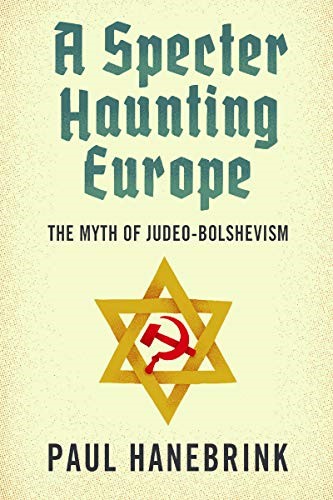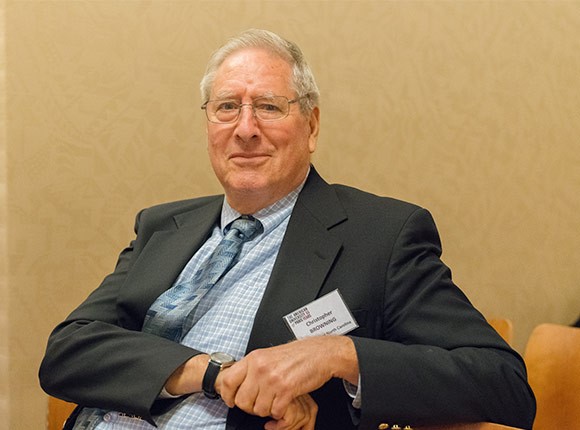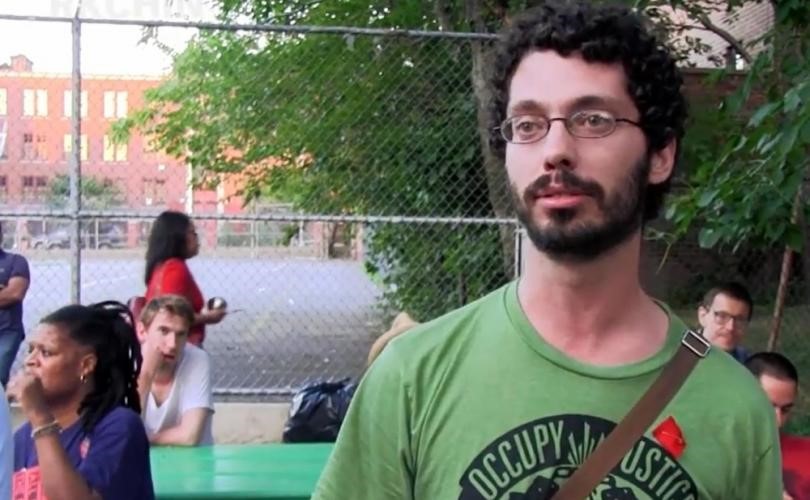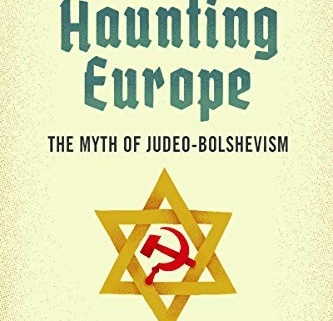Lying about Judeo-Bolshevism

A Specter Haunting Europe: The Myth of Judeo-Bolshevism
Paul Hanebrink
Harvard University Press, 2018.
The writing and discussion of Jewish historiography in contemporary mainstream academia requires a sublime choreography. It’s basically a series of evasions resembling dances, in which facts are presented and parried, and flamboyant narratives are advanced which everyone knows to be false but which emerge repetitively and shamelessly. My attention was first drawn to Paul Hanebrink’s A Specter Haunting Europe: The Myth of Judeo-Bolshevism by Christopher Browning’s recent glowing review, titled “The Fake Threat of Jewish Communism,” in the New York Review of Books. Browning is an establishment historian with a record of legally assisting Jews — for the right price. As well as receiving over $30,000 from Deborah Lipstadt to testify against David Irving, Browning has testified against a significant number of European ex-soldiers at war crimes trials. Although his most notable work, Ordinary Men: Reserve Police Battalion 101 and the Final Solution in Poland (1992), contains the less than remarkable thesis that war turns ordinary men into killers, Browning’s dedication to the Jewish narrative has led to his becoming a true guru of Jewish victimology. Having received awards and funds from organizations including Yad Vashem and the USC Shoah Foundation Center and copious promotion in mainstream media and academia, Browning’s certificate of praise in the field is potentially career-making. Evidently, he has chosen to bestow his magic touch on Paul Hanebrink. In this essay I want to explore the approach of both Browning’s review and Hanebrink’s text as exercises in the manufacture of duplicitous histories.
I had to look twice at Browning’s headline. My first thought was: “Really? You really want to take this subject matter on? You really think you can ‘debunk’ the facticity of Jewish Communism?” Such an endeavor would unquestionably require abundant chutzpah, but it is clear from the very beginning of the review that this will be an effort of evasion rather than outright debate. As Browning states in the opening paragraph, “Hanebrink’s approach is not to repeat what he considers an error of the interwar era—the futile attempt to refute a myth on the basis of historical facts and statistical data.” Although this evasion is predictable, it’s quite remarkable to see a more or less open admission from two allegedly masterful historians that they don’t possess facts sufficient to dispel the very “myth” they set out to challenge. To describe any such presentation of facts as a “futile attempt” seems intellectually flaccid; a concession of the weakness of one’s case.
But what is really presented here, of course, is the standard structure of Jewish historiography: avoid the facts, downplay them if concession is absolutely necessary, and move the discussion into abstractions and sophistry. Taking a page from the ADL playbook, Browning mewls coyly that “a small kernel of truth underpinned the stereotype of the Jewish Bolshevik,” but insists, regarding Communism, that “the Jew as “the face of the revolution” was a “culturally constructed” perception.” We therefore arrive at the familiar position where facts don’t matter and everything Jews don’t like is triumphantly declared a mere construct.

Christopher Browning: Virulent Philosemite
Browning’s review is littered with cliché, which in turn betrays an interpretation of anti-Semitism heavily influenced by a fellow useful philosemite, the late Gavin Langmuir. I profiled Langmuir’s research at length four years ago, during which I wrote:
Langmuir’s work mimicked Jewish productions by essentially absolving medieval Jewish populations of any responsibility in provoking negative reactions from their Christian host populations, and by ascribing to Christian/Western society a deep-seated psychological malfunction shot through with fantasy, repression, and sadism. Despite his actually very limited expertise in medieval legal history, Langmuir saw fit to quickly make grand pronouncements on the nature and origins of anti-Jewish feeling across Europe and over the course of centuries. His works, often with pitifully thin evidence of wider reading, portrayed anti-Semitism as “a primarily Western phenomenon.”[1] He arrogantly claimed to have been able to “define Christianity and categorize its manifestations, including Catholicism, objectively.”[2] He bluntly confessed in his books that “I shall not discuss pagan attitudes to Jews in antiquity.”[3] He dismissively described attempts to come to rational, interest-based, theories of inter-group conflict between Jews and non-Jews as “misguided pseudoscientific efforts of racial theorists,” and even argued that attempts to come to “common sense” explanations of anti-Semitism would prove “disastrous.”[4] Anti-Semitism was instead “both in its origin and in its recent most horrible manifestation … the hostility aroused by irrational thinking about Jews.”[5]
Browning fully subscribes to Langmuir’s line of thought, commenting on Hanebrink’s text:
The Jew of the Middle Ages, an infidel, became the Jew of the twentieth century, a political subversive. With emancipated Jews being the most visible beneficiaries of the modern commercial and industrial economy by the end of the nineteenth century, the medieval epithet of Jewish usury had already been replaced with that of rapacious Jewish capitalism, and after 1914 the image of the Jew as an economic threat was only intensified by accusations of Jewish war profiteering and black marketeering. The Jew as a clannish outsider in medieval Christendom was easily transformed into the Jew as an unassimilable minority and alien internal threat.
The factors in common in Langmuir and Browning are the total need for there to be a psychological and cultural connection between anti-Jewish attitudes in the Middle Ages and the present. This is explained in the assertions of both historians as essentially religious/irrational in origin, and these assertions are in turn supported by a frequent scattering of persuasive keywords that act as incantations that charm the reader into certain ways of seeing. Note Browning’s insistence upon the position of Jew as spiritual infidel, and the clear evasion of the very real phenomenon of Jewish usury, which is reduced in Browning’s estimation to a mere “epithet.” Jewish economic competition in the modern period is caricatured as an irrational “image,” and Jewish war profiteering is simply an “accusation.” Epithets, images, accusations, and the passive and innocent Jew. In sociological-psychological terms this is classic Freud and Frankfurt School, and in historiography it is classic Langmuir.
As with Langmuir’s sophistry, such assertions require a significant amount of either duplicity or cognitive dissonance, or perhaps both. The number of texts covering historical Jewish black-market activity alone is astonishing. We know from one Stanford-published history, for example, that in France in 1941, 90% of black market traders in one province were Jews.[6] Similarly, in Mark Roodhouse’s Oxford-published Black Market Britain: 1939–1955, it is remarked that Jews were massively over-represented in prosecutions for black-market activity in London during the 1940s.[7] The biggest war profiteer in the trade of illicit food in war-time Britain was the Jew Sidney Seymour, born Skylinsky, who received the heaviest sentence of the period for a black market offence after evading food regulations and stockpiling black-market food at his synagogue.[8] These are just two small examples plucked randomly from the available histories, but the point here is that, for Browning as with Langmuir, it is the supposedly irrational “accusation” and not the “futile” facts that matter.
Browning continues with the predictable explanation for the very real Jewish dominance on the Left:
Even before the crisis of 1918–1919, which combined the experiences of defeat and revolution for many Europeans, Jews were invariably disproportionately represented in liberal and socialist parties because they were not welcome to participate in conservative and Catholic political parties. The tendency to stigmatize anything to the left of conservative as Jewish was already evident in 1912, when the electoral victory in Germany of the liberal democrats, Social Democrats, and Catholics—who also made up the “Weimar Coalition” of 1919 that was largely responsible for drafting the Weimar Constitution, so despised by German conservatives—was dubbed the “Jew election.” [emphasis added]
We’re again in very familiar territory: when you feel you can’t avoid a fact (“Jews were invariably disproportionately represented”), and you can’t downplay it, then explain it by way of prejudice (“they were not welcome”). The problem with snapshots of history like this, as I’ve explained many times before, is what I’ve come to term a “cropped timeline explanation” — something that is extremely common in all Jewish and philosemitic historiography concerning anti-Semitism. When faced with an uncomfortable and unavoidable fact involving Jewish behavior (Leftism, usury, financial crime, pornography, etc.) one starts with assumptions of anti-Jewish prejudice and works from there. Jews are on the Left? It must be because they were excluded from the Right. Problems begin to arise when the question is asked why Jews were excluded or viewed as socially or culturally oppositional in the first place. Here, “irrational prejudice” is the last resort, but beyond it, when faced with further interrogation of that idea and the even deeper historical context, nothing is there. One is confronted with blank stares, rhetorical dead ends, and a factual wasteland.
By now I was already getting the sense that Browning was drowning in his own review, under the sheer weight of his own evasions and contortions. The questions, for any reader, were surely multiplying. Were Jews over-represented in Communism or not? If yes, how is the idea of Jewish leftism a myth? If the ‘myth’ can’t be debunked with facts, how can it be debunked by a work of academic sophistry that labels it a cultural construct? The contortions only worsen. Browning continues:
From the beginning of World War I, tsarist Russia had treated its Jewish subjects as unreliable and potentially disloyal. Its military forcibly displaced some 500,000 to one million Jews from combat zones. The very approach of the Russian army thus also instigated the flight of many other Jews from the eastern regions of the Austro-Hungarian Empire to the presumed safety of cities like Vienna and Budapest. The Russian Revolution erupted amid already existing fears about Jewish loyalty and floods of displaced Jews, and intensified those fears. The “panic” over Judeo-Bolshevism, Hanebrink argues, “flourished in ground that had been prepared by wartime paranoia about Jewish loyalty.”
This is another excellent example of the employment of cropped timeline explanations. Browning implies that concerns about Jewish leftism were grounded in a “paranoia” about Jewish loyalty but doesn’t feel the need to contextualize this “paranoia” with any historical considerations concerning the period prior to 1914. Anyone even remotely familiar with the literature, and honest in their conclusions, would assert that Russian Jewry was a ticking time bomb of radicalism, bitterly hostile to Russia, and enjoying the rabid support of Jews worldwide. Marsha Rozenblit and Jonathan Karp noted in World War I and the Jews (2017) that Jews across Europe regarded the outbreak of war as “a holy war against a barbaric, evil, and rapacious enemy, the enemy of freedom and culture, and the traditional enemy of the Jews, a modern Amalek who committed atrocities against the Jews both in Russia and in occupied Galicia.”[9] Rozenblit and Karp write that “for Jews in particular, the destruction of this enemy was of primary importance.”[10] This all fits extremely well with Kevin MacDonald’s explanation of Jewish leftism as rooted in the Jewish self-concept as victim, the extreme hostility of Jews to non-Jewish power structures, their view of leftism as providing the means and power to topple traditional elites, and an excellent way of facilitating the consolidation of their position as a hostile elite. None of this features in Browning’s commentary of course because, by his estimation, the Russian elite was merely paranoid to think that Jews were potentially dangerous.

Paul Hanebrink
At this point, I temporarily abandoned Browning and sought out Hanebrink’s text. Content aside, to me the most obvious drawback of any such project would be stark unoriginality, the monograph acting essentially as a quasi-plagiarism of the woeful The Myth of Jewish Communism: A Historical Interpretation (2011) by André Gerrits of Leiden University.[11] Poor Gerrits doesn’t even get a mention from the crafty Hanebrink, who managed to get the ever-philosemitic Harvard University Press [with a Board that is more than 40% Jewish] to publish his rather light piece of work, perhaps at least partially on the sales pitch that it was novel. Muddying the waters still further, reviews of the work of Gerrits prefigure the Browning review in their multifarious contortions. Thus, we are treated to a review of Gerrits by Eliezer Ben-Rafael of Tel-Aviv University, who asserts that Gerrits tackles “the myth of Jewish Communism” by presenting “the fascinating stories of Jewish Communism and Jewish Communists.” If debunking ideas with proof of their veracity wasn’t enough, it’s explained in one banal revelation that the myth combines “anti-Semitism and anti-Communism,” and has a link to reality in the fact that “in effect, many Jews were prominently involved in Communism not only in Russia, but also in the Hungarian and Bavarian revolutions of 1917 and, after the Second World War, in Czechoslovakia, Romania, Lithuania, Poland, and Bulgaria.”[12] Jewish Communism is thus clearly a myth because Jews were prominently involved in Communist revolutions in several countries over several decades. Right.
Paul Hanebrink’s text is political activism as much as corrupt historiography. In common with much philosemitic history, it postures as “history with a warning.” As such, the book opens not with World War I or even the Jews of Tsarist Russia, but with Charlottesville. Hanebrink is concerned by the concept of Judeo-Bolshevism because he believes it never died and that it is undergoing a resurgence not only on the Far Right but in the mainstream. Hanebrink is not alone. British Jewish historian Mark Mazower greeted Hanebrink’s book in November 2018 by writing in the Financial Times: “Paul Hanebrink’s book is a timely reminder of the intellectual tradition deployed by Republican politicians in the US when they join the loose coalition of conspiracy theorists across the Atlantic gleefully demonising George Soros.” Days earlier, another glowing review had appeared in the New York Times, authored by Jewish academic Samuel Moyn. Titled “The Alt-Right’s Favorite Meme is 100 Years Old,” Moyn’s piece argued that “The wider discourse around cultural Marxism today resembles nothing so much as a version of the Judeobolshevik myth updated for a new age.” On February 16th 2019, Jacobin published a brief and turgid piece by a couple of Swedish leftists on “The Return of Judeo-Bolshevism.” As well as being welcomed with open arms by Jewish academics and Marxist webzines, the book has also been greeted with enthusiasm by Britain’s Socialist Workers Party, essentially the remnants of the old British Communist Party. That the book is clearly a boon to Jews and Bolsheviks should presumably have no bearing on our estimation of its objective approach to the concept of Judeo-Bolshevism. But in a field rife with political activism, it certainly raises red flags.
The increase in apologetic propaganda activity in relation to Judeo-Bolshevism is no accident. Clearly Jews have been disturbed by the exponential growth in discussion of cultural Marxism over the last ten years. Although “cultural Marxism” is a different label from “Judeo-Bolshevism,” the curious will not need to investigate the former for long before they are confronted with the multitude of facts relating to the latter. Discussion and awareness of cultural Marxism is growing, and when cultural Marxism is discussed by figures like Tucker Carlson and (much as I dislike him) Jordan Peterson, millions are set on a path that features such landmarks as the Frankfurt School, the massacres of Béla Kun, and the Holodomor. Not everyone will reach those landmarks, but many will, and this is deeply concerning to those seeking to maintain control of the narrative. And so, it is entirely predictable that the establishment machine would stagger into motion, producing material intended to distance Jews from Marxism, and especially from any idea that there have been strong historic links between the two.
In his introduction, Hanebrink castigates nationalists in the United States and Europe for accusing “Jewish Communists” of promoting homosexuality and multiculturalism in their lands, even though Jews are demonstrably leading the migrant-refugee industry and have written openly of their leading role in promoting homosexuality. Even very recently, when the leader of the Washington DC Marxist-Antifa grouping was unmasked by the Daily Caller, there was little surprise at the fact he was a Jew named Joseph Alcoff. Alcoff, whose mother is the “Whiteness Studies” academic activist Linda Alcoff [who once wrote a piece titled “The Whiteness Question” before deleting it — it’s saved here]. Clearly an unhinged fanatic, Joseph Alcoff was arrested a few weeks ago after attacking a couple of Hispanic marines while screaming hysterically that they were “Nazis” and “White supremacists.”

Joseph Alcoff: Judeo-Bolshevik
The fact that people might be concerned with Jewish Communism today because Jewish Communists like Alcoff are still actively pursuing their agenda doesn’t feature in Hanebrink’s account. Instead, Jewish Communism is presented as more or less a delusion, both past and present. The problem with Hanebrink’s thesis is that it is nowhere proven, or even attempted to be proven, and yet is shot through with claims to total victory over the “myth.” On the fifth page Hanebrink writes:
Again and again, scholars, political liberals, and members of the Jewish community have debunked the claim that “Jews were responsible for Communism.” They have convincingly and authoritatively exposed the “myth of Judeo-Bolshevism” as an ideological construct.
But Hanebrink doesn’t offer a footnote citing any of these supposedly ubiquitous, convincing, and authoritative texts. This is because they don’t exist. The real myth here is therefore “the myth that Jewish Communism has been debunked,” and this is the myth that Hanebrink bases his entire approach on. He continues: “Given this history, the purpose of studying the Judeo-Bolshevik myth must be not to determine how true it is. [p.5]” Yes, he actually wrote that! I actually had to read this sentence three times before reassuring myself this was in fact a sentence published by what remains, for the time being, one of the most respected academic publishing institutions on the planet.
Like Browning, Hanebrink has a very uncomfortable time dealing with statistics. As well as demonstrating an apparent need to place the word ‘overrepresented’ in scare quotes, even when mentioning actual over-representations [p.140], he nervously mentions that between 20 and 40 percent of the Polish Communist Party was Jewish before declaring this a “dry statistic” [p.21] and quickly moving on. Unfortunately, he moves on to the equally awkward instance of trying to combat the idea of Judeo-Bolshevism by arguing pedantically that in 1917 “Jews made up 50 percent of the leadership of the Mensheviks [p.22];” a fact that probably brought little comfort to the Tsar. Hanebrink’s analysis is also woefully superficial. For example, he writes [p.25], that as Jews “turned to Communism, all broke with the Jewish milieu of their grandfathers.” Such a statement sits uneasily alongside statistics that effectively argue for the creation and presence of a new Jewish milieu within Communism, and, as MacDonald shows, continuing strong Jewish identifications among Jewish communists and other leftists. Faced with repeated over-representations of Jews, Hanebrink parries thusly [p.25]: “Useful generalizations are hard to come by.” Are they?
The lack of any discussion of Jewish ethnicity, anywhere in the text, is one of its most glaring failings, and yet it is one, predictably, that Hanebrink again tries to present as a positive. Right at the outset of the book [p.5] he asserts that a consideration of Jewish ethnicity among Communists “requires historians to impose rigid ethnic categories on men and women whose sense of themselves was always more complex and multifaceted.” No, it doesn’t. Most historians are aware of an array of ways of “being Jewish” that don’t require rigid categories but do require an assessment of ethnic identification, ethnic association, and behavior. What Hanebrink is really doing here is providing a kind of multiculturalist excuse for avoiding the explosive topic of Jewish ethnicity in Communism – something that should surely be at the heart of any thesis dealing with conceptions of Judeo-Bolshevism. “I don’t want to label these people” is in this instance the admission: “If I label these people my thesis is doomed.”
An excellent example of evasion along these lines is Hanebrink’s discussion of Béla Kun. Hanebrink argues [p.25] that there was “nothing meaningful at all” about Kun’s Jewish background while elsewhere [p.16] noting that of the 47 people’s commissars gathered by Kun for the 1919 Hungarian Soviet regime, 30 were fellow Jews. Clearly feeling that his own arguments are unconvincing, Hanebrink follows up his earlier surrender on the issue of facts with [p.25]: “Truly understanding the hopes, fears and motivations of any particular Jewish revolutionary in all their irreducible complexity is ultimately a task best undertaken by a biographer.” This is merely yet another capitulation on the issue of Jewish ethnic identity — a subject Hanebrink is simply unprepared and unwilling to address. He even transposes this reluctance into areas that border on the ridiculous. Take, for example, the following [p.25]:
These men and women gravitated toward Bolshevism for the same reasons that so many other Jews in the Russian Empire and across Europe embraced Zionism or assimilationist nationalism: to slip the bonds of traditional communities, to embrace the social and cultural opportunities that modernity offered, or to feel themselves part of the sweep of history.
It’s simply remarkable that an apparently serious scholar could discuss support for Zionism without mentioning Jewish identity, ethnicity, or perceptions of Jewish interests. Jews embraced Zionism, in Hanebrink’s quaint reading, to be “part of the sweep of history.” This is characteristic of the book’s total failure to critically approach the issue of Jewish identity.
Linked to this approach is Hanebrink’s insistence on the strictest possible meaning of Judeo-Bolshevism. As mentioned above, he presents the fact that Jews made up 50 percent of the leadership of the Mensheviks as an argument against the idea of Judeo-Bolshevism — because the Mensheviks and Bolsheviks were fierce rivals. This is nothing more than gross pedantry, because Hanebrink surely must be aware that the term Judeo-Bolshevism was a catch-all term for subversive Jewish leftism, and especially Jewish Communism as a whole, and it ignores the massive Jewish attraction to Bolshevism and their rise to the status of a [hostile] elite after the success of the Bolshevik Revolution. Strangely, throughout the book Hanebrink veers without explanation from strict interpretations like this to more wide-ranging interpretations. For example, he broadly describes the Judeo-Bolshevik elsewhere [p.8] as “an ethno-ideological zealot, a destructive border crosser intent on mobilizing local Jews and other discontented groups to overturn the social and moral order.” This is actually an excellent definition of a Judeo-Bolshevik, but it should be obvious that Jewish Mensheviks can easily fit into it, along with Jewish socialists and liberals. The reality, of course, is that Jews were reliable supporters and partisans for Communism during World War II, a period that witnessed the peak of propaganda against Judeo-Bolshevism. Rather than being a controversial opinion, this is one of the findings of Jewish historian Dov Levin in his Baltic Jews Under the Soviets, 1940–1946 (1994) and The Lesser of Two Evils: Eastern European Jewry Under Soviet Rule, 1939–1941 (1995), as well as a host of histories by other academics. And after World War II, Jews dominated communist governments throughout Eastern Europe.
Perhaps the only remotely valuable element of the book is the sixth chapter, which concerns the shift from Western understandings of Judeo-Bolshevism to the Western trope of “Judeo-Christian” civilization. Hanebrink correctly conceives of the latter as a modern sociological construct designed to place (primarily) American Jews within a “universalist rubric” [p.224] and, later, to promote the pro-Zionist image of a “transatlantic community of values” united against Islam [p.281]. This is itself part of the broader twentieth-century development in which the Jewish Question disappeared from mainstream Western discourse, only to be replaced with the ‘Whiteness’ Question and, most recently, the Islamic Question. I regard this development as one of the most crucial of the twentieth century, and as still requiring full explanation, documentation, and analysis. It goes without saying that Hanebrink doesn’t come close to offering any of these, but I’m so opposed to the terminology of an imagined Jewish-Christian civilization, and wholly presumed shared Jewish-Christian interests, that anything bursting that bubble is bound to win my nod of approval. This is though, in the final analysis, slim reward for a truly terrible piece of work.
Paul Hanebrink’s A Specter Haunting Europe is, ultimately, an extremely strange book, but all too typical of contemporary writing on Jewish history. It is thick on promises and thin in substance. It is characterized by glaring omissions and a deeply insincere analysis accompanied by a cloying philosemitism. Interestingly, the text lacks any semblance of intellectual confidence, and one feels that Hanebrink, who is presumably not himself Jewish, is surely aware of what he is creating: a blatant pro-Jewish apologetic. The reasons why a White academic might want to produce something like this are not difficult to surmise. As with Christopher Browning, such endeavors are massively incentivized. Despite being unoriginal, low on facts, and poor in analysis, Hanebrink, associate professor of history at Rutgers, has written a book published by a prestigious academic publisher (perhaps the most prestigious) and has been lavishly praised in the major organs of the mainstream media. The message from our latter-day commissars is clear: “Sell out and we’ll make you a star.”
[1] G. Langmuir, History, Religion and Antisemitism (Los Angeles: University of California Press, 1990), 15.
[2] Ibid, 13.
[3] Ibid, 275.
[4] Ibid, 19 & 67.
[5] Ibid, 265.
[6] Michael Murras, Vichy France and the Jews (Stanford: Stanford University Press, 1981), p.183.
[7] Mark Roodhouse, Black Market Britain, 1939-1955 (Oxford: Oxford University Press, 2013), p. 159.
[8] Ibid, p. 234.
[9] Marsha Rozenblit and Jonathan Karp, World War I and the Jews: Conflict and Transformation in Europe, the Middle East and America (New York: Berghahn, ), p.36.
[10] Ibid, p.37.
[11] André Gerrits, The Myth of Jewish Communism: A Historical Interpretation (Brussels: PIE Peter Lang, 2009).
[12] Eliezer Ben-Rafael, “André Gerrits, The Myth of Jewish Communism: A Historical Interpretation,” International Sociology Review of Books, Volume: 26 issue: 2, pp, 260-263, p.260.






Comments are closed.